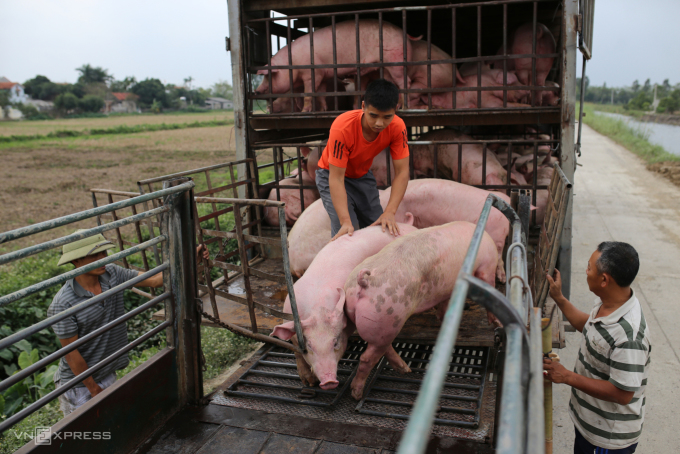At wholesale markets in the North and South, the number of live pigs is down 50-60% compared to before Tet, causing pork prices to skyrocket. Noting the recent sharp decline in supply, Mr. Hung – a trader in Dong Nai – said that last year he collected several hundred pigs a day, but now he only collects a few dozen. “Prices are high, but finding pigs of the right weight is not easy,” he said.
In the North, the consequences of Typhoon Yagi have further exacerbated the shortage. Traders said that damage caused by natural disasters has prevented many farmers from restocking, pushing pork prices up.
 Buying and selling live pigs at An Noi livestock market (Binh Luc, Ha Nam). Photo: Tat Dinh
Buying and selling live pigs at An Noi livestock market (Binh Luc, Ha Nam). Photo: Tat Dinh
Mr. Nguyen Van Chinh – Ha Nam Livestock and Poultry Wholesale Market Management Board, informed that the number of live pigs arriving each day is only 500-700, down 60% compared to before Tet. African swine fever continues to rage, while traders from the North are increasing their purchases to bring goods to the South for consumption, causing the supply to increasingly narrow.
The shortage also occurred at Hoc Mon wholesale market, the largest pork supplier in the South. The number of pigs arriving at the market on the night of February 12 was just over 2,900, down 600 from the beginning of the week and down 50% compared to before Tet.
C.P Vietnam Livestock Joint Stock Company, the unit with the largest market share in the livestock industry, said that every day before Tet, the company sold 28,000-29,000 pigs, currently there are 17,000-18,000 pigs. The weight of pigs sold at slaughter also decreased to 80-85 kg, instead of 100 kg as before.
Some large livestock enterprises have even had to sell live pigs weighing only 61 kg (early slaughter) due to limited supply. Traders are also increasing the collection of pigs from the South Central Coast to the South to make up for the shortage.
Recognizing the above situation, Mr. Giau, a farm owner and trader, said that the supply of pigs at the beginning of the year has decreased sharply due to the large amount of pigs slaughtered for the Tet holiday. The increase in piglet prices and the complicated epidemic have made many farmers more cautious.
Mr. Le Xuan Huy, Deputy General Director of C.P. Vietnam, predicted that the supply will soon stabilize thanks to the company’s regulation plan. However, he also admitted that the amount of pigs in the population is no longer as abundant as before due to the impact of epidemics and natural disasters. In addition, high agricultural prices in the past year have caused many small-scale farmers to change direction, leading to a sharp decline in the pig herd.
According to Mr. Nguyen Kim Doan, Vice President of the Dong Nai Livestock Association, the supply of pigs is significantly lacking even though the purchasing power at the market is not really strong. He said that in addition to large enterprises increasing their herds, there are still enterprises leaving their barns empty due to the sharp drop in pork prices last year. At small-scale farms, the disease outbreak is fierce, forcing many farms to close due to not meeting environmental standards, making the supply even tighter.
Although the price of live pigs is increasing sharply, Mr. Doan believes that this situation will not last long. “Farmers who see good prices will quickly restore their herds. When the supply increases again, the price may cool down,” he said. According to him, the price of 63,000-65,000 VND per kg is enough to ensure good profits for farmers.
Currently, the price of live pigs on the market fluctuates from 68,000-73,000 VND per kg, of which Dong Nai recorded a peak of 73,000 VND per kg – the highest in the past three years. This development puts pressure on the food market, while livestock farmers face the problem of balancing costs to maintain production.
Thi Ha
VietnamBiz
